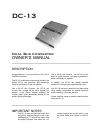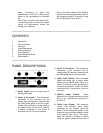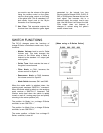
you want to vary the volume of the guitar
using the volume control on the guitar,
use the direct guitar output on the body
of the guitar itself. This is a standard 1/4”
jack usually found next to the 24-pin
connector on a G-series guitar.
7. Hex Fuzz: This connector outputs the
line-level hex fuzz distortion guitar signal
generated by the internal hex fuzz
circuitry inside a Roland G-202, G-303, G-
505, or G-808 guitar. Because this is a line
level signal, and because this is a
distorted signal, the output level is very
high. Like the Guitar Line Output, the Hex
Fuzz output
does not
respond to
changes in volume using the guitar’s
master volume knob.
_______________________________________
SWITCH FUNCTIONS
The DC-13 changes some the functions of
vintage G-Series controllers to match new, 13-pin
functions.
• Master Volume knob is now for Guitar
Volume only. This knob changes the
volume of the Guitar when a cable is
hooked to the standard 1/4” output jack
on the guitar.
• Guitar Tone Knob controls the tone of
the guitar’s normal sound.
• Filter Knob, or CV#1, becomes the
volume control for Synth A.
• Resonance Knob, or CV#2, becomes
the volume control for Synth B.
• Mode Switch becomes SW1 and SW2.
When the mode switch is switched down, the
receiving synth receives a “SWITCH 1” command.
When the mode switch is switch up, the receiving
synth receives a “SWITCH 2” command. This
function works best when the switch is rapidly
turned on and off, moving away from and quickly
returning to the center position (off).
The position for Mode I on a vintage G-Series
controller, is now “SWITCH 1.”
The position for Mode III on a vintage G-Series
controller, is now “SWITCH 2.”
The center position, or Mode II on a vintage G-
Series controller, is now off.
[When using a G-Series Guitar]
G-202, 303, 505, 808
G-707






